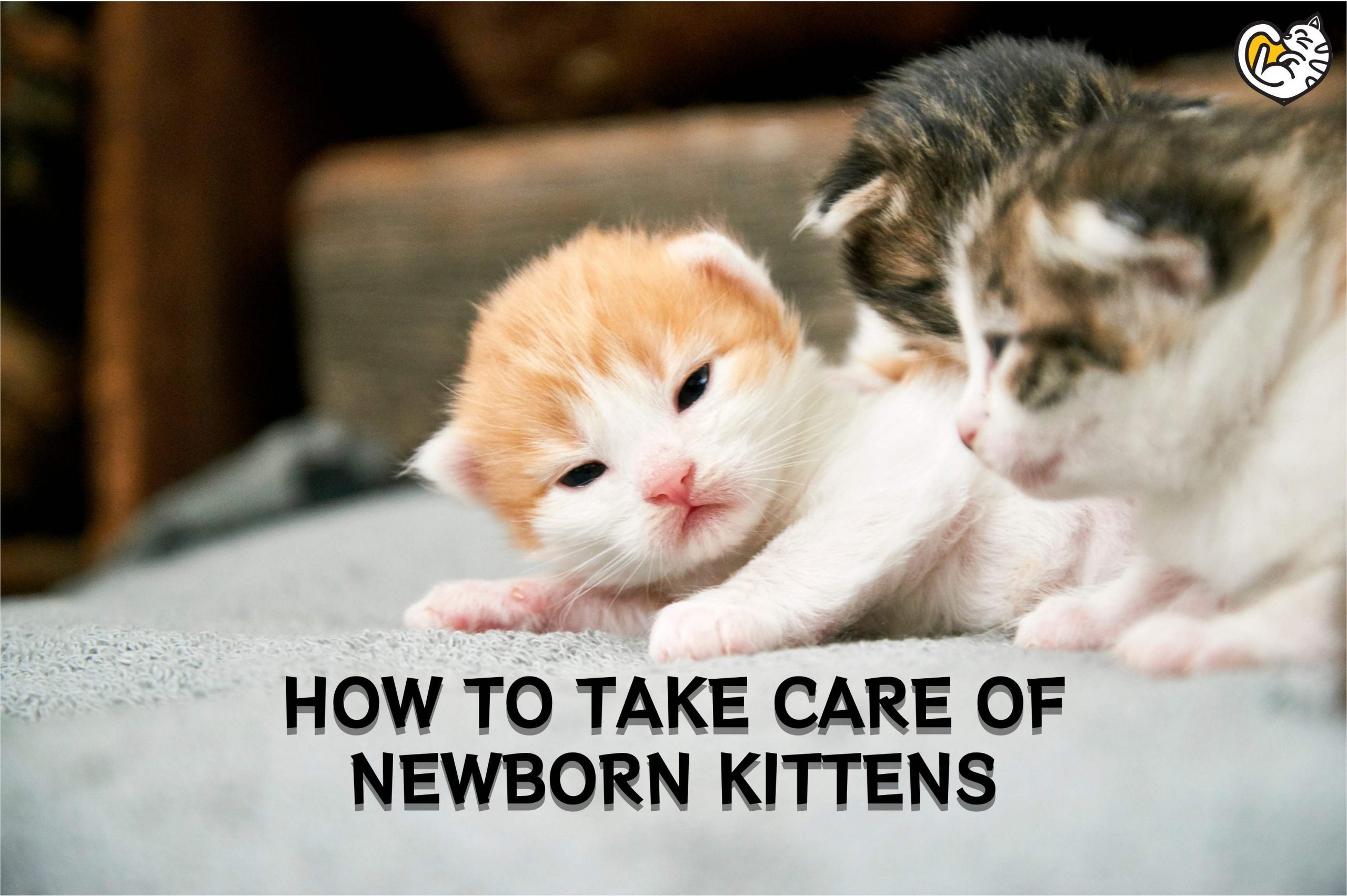How to Take Care of Newborn Kittens


Having a kitten at home is a wonderful experience, but things can sometimes go wrong and the mother may not be able to care for the kitten. This is when you need to know what to do to save and raise the kitten yourself. So, in this article, we will look at how to take care of newborn kittens.
Just like babies, newborn kittens are susceptible to dangerous infections and should be given extra care. It is crucial to provide them with the best possible environment to grow healthy during the first few weeks after they are born.
Is Your Cat Picky About Food?
Well, my cats used to be like that too, but now they finished the food all the time!
If your cat doesn’t want to eat the food or finish the food you gave, I have a solution for you. Read my true story here.
How to Keep Your Kitten Warm
Kittens under four weeks of age do not have the ability to thermoregulate (regulate the body temperature). As a caring owner, it is your responsibility to help your kitten gets warm. One of the best ways to achieve this is to place a warmed Snuggle Safe disk at the crates or cage opening. Remember, kittens are born blind and must always be kept safe and warm. Using a heating pad, along with a soft blanket, can help keep the kittens warm.
The perfect body temperature for cats is between 37.2 to 39.2 degrees Celsius. Kittens should be placed in a cage or carrier with a low-level pet-safe heating pad and covered with a clean, soft cloth until three to four weeks old. A heating pad or heating bed specifically designed for pets is preferable to a human heating pad. It is available at most pet shops or online. When using a human heating pad, please set it to the lowest level and cover it with layers of soft and clean material to prevent the kitten from overheating.
If the kitten is more than four weeks old and the room is below 21 degrees Celsius, continue to keep the kitten on a heating pad. Make sure there is a small space in the pet carrier that is free of a heating pad. So that if it gets too hot, the kitten can go over to the cooler part of the cage to cool off.
What to Feed Newborn Kitten
Kittens less than two weeks old cannot consume solid food, whether canned or dry. Like mammals, they get all the nutrients they need by drinking their mother's milk. The mother's milk will provide all the good things that a newborn kitten needs.
The kittens will depend on you to survive if their mother is not around. Contact a veterinarian or an animal shelter if you can't get suitable milk for your kitten. They may have another mother cat who will care for and breastfeed your kitten. Else, you will have to learn to bottle-feed your kitten a commercial milk replacer. You can easily buy a kitten milk replacer (KMR) in pet shop or online. If you are not sure which KMR to use, consult a veterinarian to assist you in making the best decision.
Weaning is the process of transitioning your kittens from their mother's milk (or bottle feeding) to solid food. The weaning process begins at around four weeks old and is usually completed around the eight-week mark. The transition should take place gradually to avoid stomach upset.
When your kitten is three or four weeks old, you can start giving them the milk replacer in a small bowl, followed by a gradual transition to an easily digestible wet food, preferable in puree or mousse form. Kitten gruel with warmed milk replacer is excellent first food. Special canned kitten food will also work well. Serve this to your kitten in a shallow bowl many times a day. They should be accustomed to this diet by the age of five weeks, and by six to eight weeks, they should be able to eat dry food such as freeze-dried pet food and kibbles. Make sure to crush the dry food into tiny pieces to be easy to chew and digest. This is also the time to introduce clean water in a shallow dish.
Can I Feed Kitten Cow Milk or Goat Milk?
To answer this, we will say that the only healthy choice for kittens is mother milk or a kitten milk replacer. Never give your kitten cow's milk. It is not suitable for kittens because they do not have the enzymes needed to digest the lactose in cow milk. Giving them cow milk can cause diarrhoea and dehydration. Therefore, it is important to keep kittens away from cow milk.
If you search online, you may discover that some sites recommend goat milk for kittens. Still, many veterinarians advise against giving goat milk to kittens because, like cow's milk, goat milk does not provide adequate nutrients for kittens. Goat milk is far too low in fat and protein; thus, it should not be used as replacement milk for unweaned kittens. Superior kitten formulas that are complete, balanced and suitable for a kitten's digestive system are readily available in the market.
Can I Feed Kitten Adult Cat Food?
A kitten has different nutritional needs than an adult cat. It needs kitten food which is higher in proteins and fats to support the rapid growth. Adult cat food does not provide the proper nutrition that a kitten requires.
Nevertheless, if the pet food label says it is suitable "for all life stages", that means it is safe for both kittens and adult cats to eat.
How to Feed a Newborn Kitten?
Ensure the kitten is warm: Keeping the kitten warm is more important than feeding, particularly for kittens in less than three weeks. Never feed a cold kitten. Instead, warm it up slowly using a heating pad or by wrapping it in a towel or blanket. Ensuring that the kitten is warm is essential because it cannot digest appropriately if its body temperature is low.
Get the formula ready: Warm the kitten formula to a temperature little above room temperature. Before you feed your kitten, check the temperature of the formula. To ensure it is not too hot, place a few drops of the formula on your wrist.
Use syringe or bottle: Bottle feeding is the standard way to feed orphaned kittens. You may also use a syringe (without the needle) to feed a kitten under two weeks old because this is easier to measure in small increments.
No matter which feeding tool you are using, ensure not dispensing too much milk into a kitten's mouth at one time to avoid drowning. Allows the kitten time to swallow and breathe.
Ensure you wash your hands and the syringe or bottle you used to feed your kitten before and after each feeding.
Gently feed the kitten: The kitten should be lying next to you on its stomach, similar to how it would nurse from the mother. While your kitten sits on your lap, wrap it in a warm towel. Look for a comfortable position for both of you.
It is also a good idea to wear a robe or blouse that you only put on when handling or feeding your kitten. The use of a robe helps to minimise the chance of spreading germs.
How Often Should I Feed a Kitten?
The general idea is that a newborn kitten should eat every two or three hours, depending on the age and how much it eats at each meal.
If your kitten is less than two weeks, you shall bottle-feed it at least every two hours. If your kitten is two to four weeks, it is recommended that you bottle-feed your kitten up to six times a day.
Some vets recommend free feeding for young kittens, which means providing an unlimited amount of food throughout the day to encourage them to eat. This is fine for kittens as they are in explosive growth, which requires triple the energy needs of an adult cat. However, free-feeding is not recommended for adult cats, as it can lead to obesity and other health problems.
When kittens are six to eight weeks old, they should be fed four times a day with lesser milk. You can organise the schedule to fit your routine, although it is best to maintain a consistent routine from day to day.
Do I Need to Burp a Kitten?
You have to burp the kitten after each feeding of formula. Hold the kitten against your shoulder and pat it gently until you feel it burps. Like human babies, you do not always hear them burp; however, you will feel them do it instead.
Stimulate Urination and Defecation
Kittens cannot pee or poop on their own until they are three to four weeks old. Usually, the mother licks her kittens to stimulate them to pee and poop. If you are responsible for caring for newborn kittens, you will need to help stimulate them after each feeding. Young kittens should pee after each feeding and poop one to four times per day.
To stimulate a kitten, you will need to prepare soft, absorbent and disposable cloth-like tissues or toilet paper. Avoid harsh materials like thick paper towels that can irritate your kitten's skin.
Grab your kitten with one hand and gently rub its genital region using soft tissue in a circular movement. The kitten will start peeing within a minute. Keep stimulating the kitten till it stops peeing. It could take anything between 10 to 40 seconds, depending on the kitten's age.
If your kitten needs to poo, stimulate its bottom while it is pushing to help your kitten uses its muscles to pass stool. Keep stimulating until the kitten has finished its business. Don't forget to clean and dry the private parts.
When your kitten reaches three-week age, it is time to introduce it to the litter box. Put the kitten in the box, let it explore the litter and it will usually learn to use within a few days.
Can I Bathe a Newborn Kitten?
It can be challenging to try something new with a kitten, especially bathing. Because most adult cats dislike water, it is reasonable to assume that kittens won't like it too.
Young kittens are fragile creatures. Bath is not recommended for kittens under eight weeks unless you have a perfect reason. We advise you to use a soft and wet cloth to spot clean dirty areas of your kitten's fur instead of giving the kitten bath. If there is any severe infection, such as flea infestation, you can bathe your kitten with warm water with a minimal amount of mild kitten shampoo. Do not use human shampoo or adult cat shampoo as they can be too harsh for young kittens. Try to avoid the eyes, mouth and ears when bathing your kitten; you can use a towel around the face and rinse well.
The main reasons bathing is not recommended for kittens under eight weeks old are because they are susceptible to environmental changes and the body systems have not fully matured. Kittens cannot regulate their body temperature well, so they can catch colds very easily. Bathing them can be stressful and can lead to other complications that need to be avoided.
How to Bathe a Newborn Kitten
If bathing a kitten is inevitable, make sure the bath is as comfortable as possible so as not to cause unnecessary stress on the kitten.
Temperature is the key. Remember that a cat's average body temperature is 37.2 to 39.2 degrees Celsius. Use a hot shower to warm up the bathroom before bath time to create a warm environment. The bathwater itself should be warm, but not hot or cold. Use a thermometer if necessary.
While you need to work as quickly as possible, do not stress out your kitten. If it starts to get scared, you can try giving your kitten treats or take a little break by removing it from the water and wrap in a dry towel.
Avoid putting your kitten under running water as this can scare it. Instead, use a sink or big bowl to fill the bathwater. After the bath, make sure the cat is completely dry to prevent it from getting cold. If you want to use a hairdryer to blow dry your kitten, make sure the temperature is not hot by using the "warm" setting.
Remember to keep an eye on the kitten after drying. If the kitten seems cold or unresponsive, keep it warm and contact the veterinarian immediately.
Kitten Socialisation
Socialising your kitten is a significant part of raising a friendly and well-adjusted cat. The perfect time to socialise a kitten is when it is between two and seven weeks of age. Kittens are most receptive to new experiences and ready to learn at this age. By three weeks of age, the kitten has started with self-play and batting of objects, as well as social play among littermates. Social play grows from 4 to 11 weeks and peaks at 12 weeks. Playing is also a great way to socialise and bond with your kitten early in the relationship.
You can start socialising your kitten with other people occasionally. Use treats and toys to help the kitten see these connections as positive and desirable. Begin to introduce two or more people and different noise levels as your kitten gains confidence.
Allow your children or your friends and family children to interact with your kitten. Children and cats are lovely companions. Socialising your kitten with them is a good idea, especially if you plan to have children or invite family and friends' children to your home. Keep any interactions between the cat and the children calm and safe.
Kitten Weight Gain and Development Signs
Depending on the breed and the size of the litter, newborn kittens typically weigh around 100 grams. Every day, a healthy kitten should gain at least 10 grams. It is usually a symptom of sickness if you do not notice any growth in your kitten body size.
It is vital to record your kitten's body weight and how much it eats daily. When measuring pets this small, a gram scale can be used for accuracy. Consult your veterinarian immediately if your kitten is not eating or growing as expected.
Please refer to the table below for a kitten's average weight and some significant physical development over time:
Kitten Weight Gain and Physical Development Table
| Age | Average Weight | Physical Development |
| 1 - 5 days | 1.8-5.3 ounces (50-150 grams) | The kitten cannot hear or see; its eyes and ears are closed. It has no teeth, and its nose, gums, and paws may appear bright pink. |
| Week 1 | 5.3-8.8 ounces (150-250 grams) | One-week-old kitten's eyes will start to open and the eyesight is unfocused. Its ear canals will gradually begin to open. The claws will still be non-retractable. |
| Week 2 | 8.8-12.3 ounces (250-350 grams) | Two weeks kitten will become more coordinated and will attempt its very first step. The eyes are now open and will be in blue. |
| Week 3 | 12.3-15.9 ounces (350-450 grams) | Three weeks kitten will start walking, exploring the surroundings and even the litter box. The ears are unfolded. |
| Week 4 | 15.9 ounces-1.2 pounds (450-550 grams) | Four weeks kitten will have much-developed vision and hearing. The canine teeth will start to come through the gums and its claws will be retractable. The kitten should be able to eliminate urine and faeces on its own. |
| Week 5 - 6 | 1.2-1.7 pounds (550-750 grams) | The premolars (teeth at the back) will begin to grow. The vision and hearing will be fully developed. |
| Week 7 | 1.7-1.9 pounds (750-850 grams) | At seven weeks, all 26 kitten teeth will be present. The blue eye colour will be changing and the adult eye colour will start to emerge. If male, the testicle will begin to descend. |
| Week 8 | 1.9-2.1 pounds (850-950 grams) | At week 8, the eyes will completely transit to adult eyes colour of blue, green, orange, yellow or brown. The kitten is now ready for the first shot of vaccination. |
When Should My Kitten Be Dewormed?
Worms or parasites are common in kittens; thus, all kittens should be treated with drugs to kill the parasites from about three weeks of age; consult your vet for this. It is essential to deworm your cat at a young age because parasites can cause bloody stool, diarrhoea, vomiting, dehydration and even death if not treated properly.
Can My Kitten Catch Flu?
Cat flu is highly contagious and kittens usually catch it from the mother. Cat flu often affects a kitten more severely than an adult cat. If you notice signs of cat flu such as sneezing, runny eyes or nose, lethargy and fever, see your vet immediately.
Conclusion: How to Take Care of Newborn Kittens
Most kittens typically become adults at around 12 months of age. Some larger breed cats, like Maine Coon, can take 18 months to 24 months to be fully matured, though.
It requires a lot of patience, especially in taking care the newborn kittens aged below 8 weeks. Remember, your kittens are learning something new every day and you must allow them more time to adapt. Not to rush, but do things on the kitten's timeline, not yours. Your physical and emotional contact is extremely important for a growing kitten.
Do you know the biggest challenge faced by cat owners?
It’s not what you think. Find out the answer here (before it’s too late).





